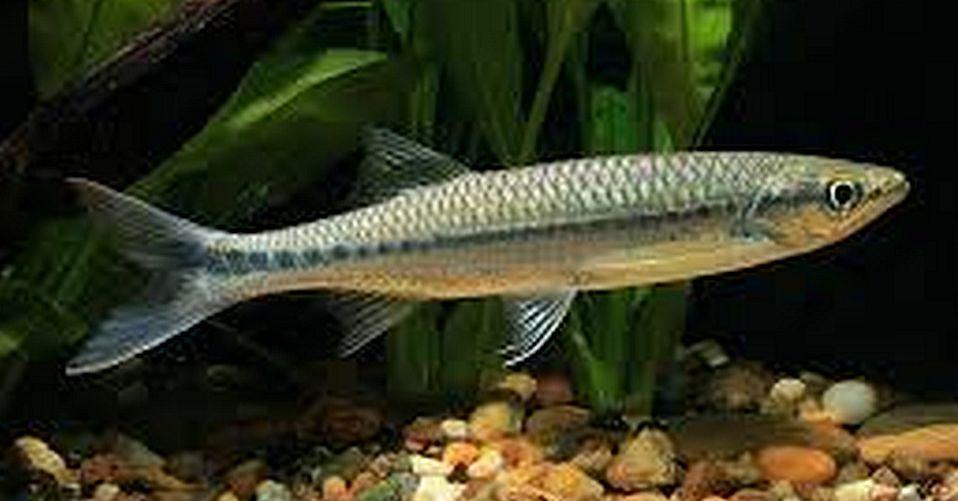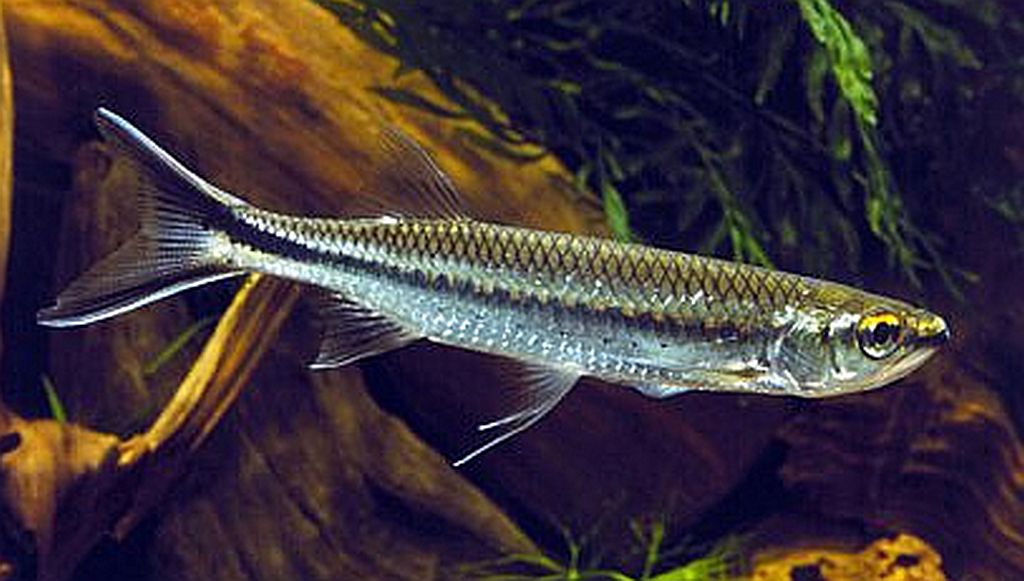The Apollo Shark (Luciosoma spilopleura) is a beautiful, fast moving, torpedo shaped Cprinid that is found in the Malay peninsula, Thailand, Borneo, Brunei, and Sumatra.
Also known to tropical fish keeping enthusiasts as the Apollo Sharkminnow, Apollo Sharks are active surface swimmers that inhabit clear fast flowing forest rivers and streams with rocky, stone, or gravel bottoms that posses a high level of dissolved oxygen.
They are a skittish, shoaling species related to Rasboras, that grow quite large in their natural environment and require a lot of swimming area, and although they are active predators, when kept in shoals, they make superb additions to community tanks with large cichlids and catfish.
The Apollo Shark has an elongated, cylindrical body with short whiskers and a pointed snout which is quite different from other Cyprinids. They have a forked caudal fin and a dorsal fin that is set far back on their body.
Above the dark lateral line that extends from the nose through the caudal fin, healthy adult specimens are colored an almost olive green. Below the lateral line, they are a silvery white color.
Juveniles are more silvery colored. Except for the females having a more rounded belly, the sexes are indistinguishable.
Apollo Sharks need to be housed in a tightly covered aquarium of at least 125 gallon capacity that has plenty of swimming area, high levels of dissolved oxygen, and a good deal of water movement. Their tank should have a gravel or rocky substrate with a background of aquatic plants and some minimal driftwood or bogwood
decorations. The greatest need for these fish is a lot of free swimming space. Tank decorations that clutter up their swimming areas should be avoided.
Although Apollo Sharks are active predators that spend most of their time on or near the surface of the tank, on occasion they will forage on the bottom. In a community tank setting, they are peaceful when housed in small shoals of 6 to 12 fish, but do not do well when kept individually or in small groups of 2 to 3 specimens. They are best kept with other robust similar sized species such as Tinfoil Barbs and Bala Sharks. Smaller fish could be viewed as food.
Apollo Sharks are energetic swimmers that are easily startled and because they occupy the uppermost portion of the water column, a tightly fitting tank cover is mandatory for these expert jumpers. Canister filters and powerheads are also a good choice for this species to ensure the pristine water quality and high oxygen levels they require in their tank.
There are no documented cases of Apollo Sharks being bred in an aquarium environment. Most specimens in the aquarium hobby are wild caught.
Apollo Sharks are easy to feed and will eat all sorts of fresh, frozen, or freeze dried foods. Although they will eagerly eat fish smaller than themselves, they can be fed a diet of bloodworms, frozen fish, mosquito larvae, vitamin enriched brine shrimp, mysis shrimp, chopped worms, etc. Larger specimens will eat chopped prawns, Krill
, ghost shrimp
, etc. Over time they will also accept slow sinking omnivore pellets and flake foods.
Feed these fish either one large serving a day or smaller quantities twice a day. If you feed them frozen fish or beefheart, feed it to them 2 or 3 days apart.
Apollo Sharks are not common in the aquarium trade but tropical fish keeping enthusiasts can occasionally purchase them from specialty fish shops and online at modest prices when they are anywhere from 3″ to 8″ in length.
Minimum Tank Size: 125 gallon
Care Level: Moderate
Temperament: Semi-aggressive
Aquarium Hardiness: Hardy
Water Conditions: 75-82° F, dGH 2 – 20, pH 6.0-7.5
Max Size: 10″
Color Form: Green, Silver
Diet: Omnivore
Compatibility: Large shoals, large community tanks
Origin: Southeast Asia, Borneo
Family: Cyprinidae
Life Span: 14+ years
Aquarist Experience Level: Intermediate




